If I have any understanding of compassion and the practice of the bodhisattva path, it is entirely on the basis of this text [ The Way of the Bodhisattva ] that I possess it.H. H. the Dalai LamaThis is a must-have, must-read, must-contemplate, and must-follow book for those who wish to exercise the privilege of being heir to Shakyamuni Buddhas unique heritage.Dzongsar Jamyang Khyentse, author of What Makes You Not a Buddhist What a tremendous blessing and joy it is that Khenpo Kunpels renowned commentary on the Bodhicharyavatara , based on the definitive oral instructions of the great saint and master of compassion Patrul Rinpoche, is now available in such a fluent and authoritative translation. This is a modern classic for our timesan exceptionally clear and comprehensive guide to Shantidevas timeless verses, an encyclopedic treasury of Buddhist wisdom, and an inspiring companion for all who seek to follow the compassionate path of the bodhisattvas.Sogyal Rinpoche, author of The Tibetan Book of Living and Dying ABOUT THE BOOKThe Bodhicharyavatara , or Way of the Bodhisattva , composed by the eighth-century Indian master Shantideva, has occupied an important place in the Tibetan Buddhist tradition throughout its history. It is a guide to cultivating the mind of enlightenment through generating the qualities of love, compassion, generosity, and patience. In this commentary, Kunzang Pelden has compiled the pith instructions of his teacher Patrul Rinpoche, the celebrated author of The Words of My Perfect Teacher. KUNZANG PELDEN (sometimes known as Khenpo Kunpel) was born in Tibet in 1862. Renowned for his spiritual realization, he was one of the great monk-scholars of the nonsectarian movement and was instrumental in the preservation of the oral traditions and teachings of the Nyingma school.Sign up to learn more about our books and receive special offers from Shambhala Publications.

Or visit us online to sign up at shambhala.com/eshambhala.

Buddha Shakyamuni
The Padmakara Translation Group gratefully acknowledges the generous support of the Tsadra Foundation in sponsoring the translation and preparation of this book.

The Nectar of Manjushris Speech
A Detailed Commentary on Shantidevas Way of the Bodhisattva

Kunzang Pelden
Translated by the Padmakara Translation Group

Shambhala Boston & London 2011
Shambhala Publications, Inc.
Horticultural Hall
300 Massachusetts Avenue
Boston, Massachusetts 02115
www.shambhala.com
2007 by the Padmakara Translation Group
Cover art used by permission of The Metropolitan Museum of Art, Kennedy Fund, 1915. (15.95.154) Photograph 1991 The Metropolitan Museum of Art
All rights reserved. No part of this book may be reproduced in any form or by any means, electronic or mechanical, including photocopying, recording, or by any information storage and retrieval system, without permission in writing from the publisher.
The Library of Congress catalogues the hardcover edition of this book as follows:
Kun-bzan-dpal-ldan, Mkhan-po.
[Byan chub sems dpai spyod pa la jug pai tshig grel Jam-dbyans bla mai zal lun bdud rtsii thig pa. English]
The nectar of Manjushris speech: a detailed commentary on Shantidevas Way of the Bodhisattva / by Kunzang Pelden; translated by the Padmakara Translation Group.
p cm.
Includes bibliographical references and index.
eISBN 978-0-8348-2266-5
ISBN 978-1-59030-439-6 (hardcover: alk. paper)
ISBN 978-1-59030-699-4 (paperback: alk. paper)
1. Santideva, 7th cent. Bodhicaryavatara.
I. Comit de traduction Padmakara.
II. Title.
BQ3145.K7613 2007
294.385dc22
2007015600
Contents
In an age buffeted by the horrors of war and terrorismto which the only response that most of us can imagine is retaliation with its endless consequenceswhat great good fortune it is, and how comforting to the mind, that there is still such a thing as bodhichitta! In times like these, even to hear of the idea of it is almost inconceivable. Yet here we have in our hands a manual that can actually teach us how to practice it and thereby lead us to buddhahood.
All the Buddhas and Bodhisattvas, including our teachers in the present age, have said that they started out upon their path by rigorously training in bodhichitta. I feel immense gratitude to all of them, first to Shantideva and then to our teachers: His Holiness the Dalai Lama, Kyabje Kangyur Rinpoche, Kyabje Dudjom Rinpoche, Kyabje Dilgo Khyentse Rinpoche, Kyabje Trulzhik Rinpoche, Dzongsar Khyentse Rinpoche, and my brother Pema Wangyal Rinpoche. All of them have taken these teachings beyond the stage of mere interest and inspiration; they have accepted them as their path and seriously pursued them. It is thanks to masters like these that this path is still available to us now.
What I most remember about my teachers is that they let their deep interest, their fascination with bodhichitta sink deep into the core of their being. And it was not interest alone that satisfied them; they let themselves be molded by these teachings, with results that became visible and tangible. They were not content to think what a beautiful path this iswhile still continuing to resent and complain about others!
I am confident that this book describes the path that all our teachers have taken, and I am very encouraged that it is available for people like me, so that we can actually follow their example, train our minds, and cultivate compassion, humility, and the other Bodhisattva qualities.
I hope those who read this text will be inspired to receive direct instructions on the Bodhisattva path from authentic teachers. I pray that this text will not simply arouse admiration or interest in the ideas that it contains, but that its teachings will really sink into our minds and transform usthe sign of success being that we will apply them to ourselves without judging others.
I am grateful to everyone who has worked on this book. May it truly fulfill the aspirations that our teachers have made for all sentient beings.
Jigme Khyentse Dordogne , 2006
The Bodhisattvacharyavatara (conveniently abbreviated as Bodhicharyavatara ) composed by the eighth-century Indian master Shantideva has occupied an important place in the Tibetan Buddhist tradition almost from its inception. Shantarakshita (725783), the renowned abbot of the great university of Nalanda, invited by King Trisongdetsen to help in the establishment of the Buddhist teachings in Tibet, could scarcely have been ignorant of the life and achievements of his remarkable contemporary and confrere, and it is clear that when he inaugurated the great work of translation of sutras and shastras into Tibetan, the Bodhicharyavatara figured prominently among the many texts brought from India for that purpose.
Its first translator, Kawa Peltsek, was one of the first seven men (the so-called sad mi mi bdun ) chosen to take part in an experiment to see whether Tibetans were capable of holding monastic vows. And since their ordination is said to have occurred in 767, we may conclude that he was born around 740. In any event, the fact that the Bodhicharyavatara should have been translated so soon after its composition (it is quite possible that Shantideva was still alive), on a par with other texts considered to be of the first importance for the propagation of Buddhism in Tibet, testifies to the speed with which the work had established itself already in India, or at least at Nalanda, as what we would nowadays call a popular classic. Butns statement, repeated by Kunzang Pelden, that a hundred and eight commentaries were composed on the Bodhicharyavatara in India alone is perhaps a pious exaggeration, but there can be no doubt of the esteem (following the universal astonishment that had greeted its first recitation) in which it was held, both in its native country and in Tibet. The Tengyur contains ten Sanskrit commentaries rendered into Tibetan, the most important of which, the Panjika of Prajnakaramati, has also survived in the original language. The translation of so many commentaries suggests that the Bodhicharyavatara was widely taught and studied. This is hardly surprising, for it is a detailed exposition of the gradual, systematic practice of the paramitas, and as such was tailor-made for the kind of Mahayana sutra tradition that Shantarakshita was at pains to transmit to the Tibetans, and which, a generation later, his disciple Kamalashila is said to have defended so successfully against the inroads of the Chinese Chan tradition.
Next page
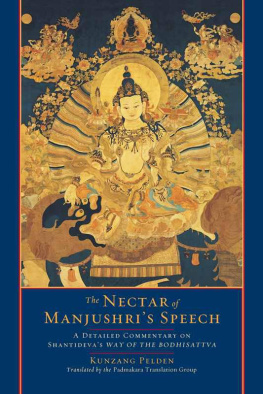
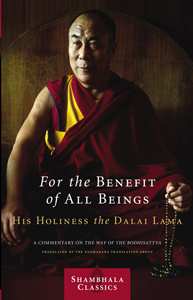
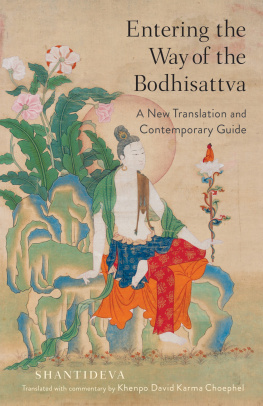
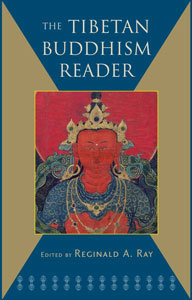
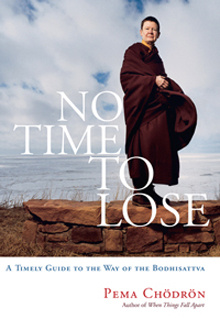
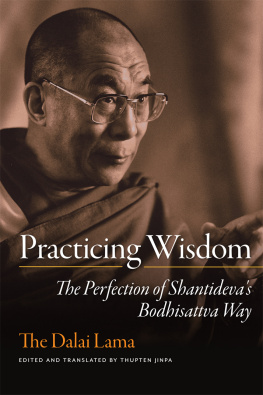

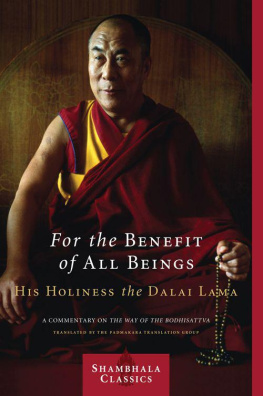
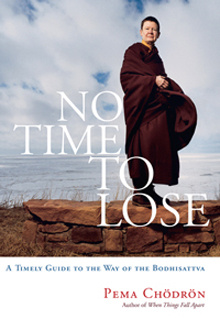
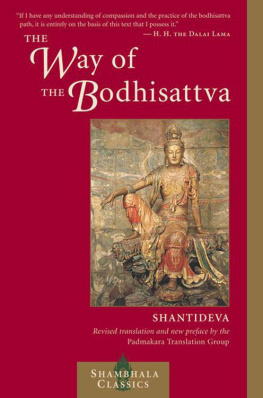

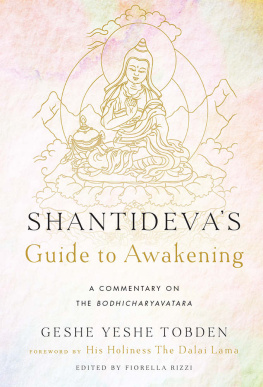
 Or visit us online to sign up at shambhala.com/eshambhala.
Or visit us online to sign up at shambhala.com/eshambhala. 


